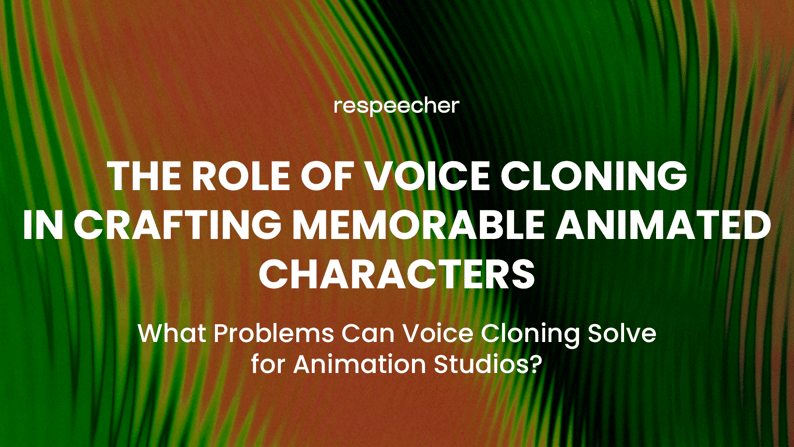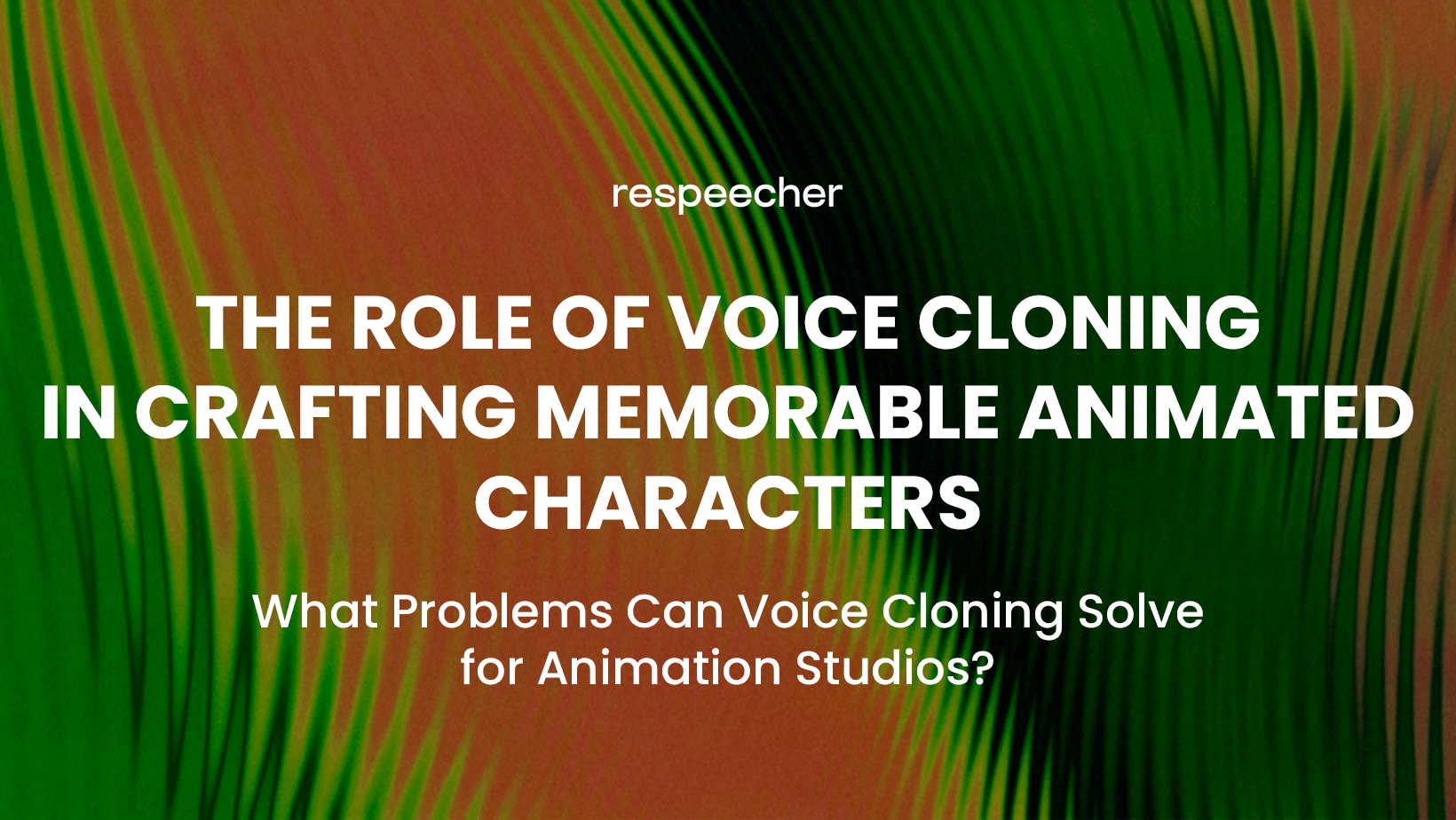The Role of Voice Cloning in Crafting Memorable Animated Characters

The evolution of voice casting in animated productions has been marked by integrating AI technology, enhancing efficiency and flexibility. Studios continue to rely on voice actors' talent and expertise, recognizing their invaluable contributions to the creative process. However, introducing AI voice cloning complements this relationship, enabling studios to meet diverse production needs more effectively. Animation studios today can create digital replicas of actors' voices and use them in their work. Once permission to utilize a voice is granted, producers and directors can handle post-production without requiring the actor's presence. This innovation has proven to be beneficial for everyone involved in the film production process. Animators can now allocate resources more strategically, and actors obtain a new source of income.
Rather than replacing traditional voice actors, AI voices have emerged as complementary tools in the animator's arsenal. The synergy between AI voices and human voice acting is a testament to the versatility of modern animation techniques.
AI voices also serve as a creative catalyst, allowing animators to experiment with unconventional characters and unique vocalizations that might be challenging for human actors to emulate. The synthesis of AI and human voices allows for a harmonious blend of authenticity and innovation, enabling animators to push the boundaries of character development.
AI voices offer other benefits, such as effortlessly voicing hundreds of characters and replicating voices in numerous languages, augmenting the creative process. This capability empowers animators to easily explore a diverse range of characters and dialects, enhancing the richness and authenticity of animated worlds.
Furthermore, the popularity of AI voices has paved the way for a democratization of character creation. Smaller studios and independent animators can now access high-quality voice synthesis tools like our Voice Marketplace, empowering them to compete on a broader scale with larger, more established counterparts. This democratization has led to diversifying storytelling voices in the animation industry, fostering creativity and innovation.
What Problems Can Voice Cloning Solve for Animation Studios?
Consistency Across Productions. Traditional voice casting may challenge maintaining consistency in character voices, particularly in long-running series or sequels. An obstacle could be the actor's aging or employment in other projects. AI voice cloning software ensures a consistent and recognizable voice for characters, mitigating the risk of audience disconnection due to unexpected vocal variations and allowing voice actors to scale their work.
Mutual Benefits. Having professional voice actors in the studio all the time when edits are needed can be inconvenient for everyone involved. Voice cloning for animation allows the creation of digital replicas of their voices, so producers can use them in their work, and actors get an additional revenue stream. It simplifies the film production process and makes it beneficial for everyone involved.
Time Efficiency. Traditional voice recording sessions may be time-consuming, especially when coordinating schedules with busy voice actors. Voice cloning tools can create digital replicas of actors' voices, reducing the time required for recording sessions and enabling faster production timelines. It also allows voice actors to deliver more projects.
Flexibility in Iterative Changes. Revisions or changes to a character's voice after initial recording sessions can be logistically challenging and time-consuming. AI voice cloning allows for flexible adjustments, enabling animators to iterate on character voice generation seamlessly. The voice actors don't have to return to the studio during post-production. Instead, they are free to work on other projects and more easily increase their revenue.
Preservation of Voice Legacy. Challenges arise when a voice actor is unavailable due to unforeseen circumstances, impacting the continuity of a character's voice. Voice cloning ensures the preservation of a character's voice legacy, allowing studios to maintain the essence of a character even when faced with unexpected changes in casting.
For example, Respeecher helped clone Michael York's voice after it was affected by bone marrow cancer and an under-diagnosed condition called amyloidosis, in a meaningful healthcare project. The project team used AI voice cloning software to record York’s voiceover to an old video he recorded. The new audio effectively matched the original narration and rendered his unique vocal quality, signature tone, and cadence.
Global Accessibility. Geographical constraints or scheduling conflicts may restrict access to renowned voice actors. Voice cloning transcends geographical barriers, providing studios with access to a worldwide pool of voices and reducing dependency on the availability of specific actors.
"We worked with Respeecher to recreate my voice in Ukrainian to as part of our education initiative 'BecomingX Ukraine'," says Bear Grylls, famous TV presenter, and adventurer. "The technology is phenomenal and the result is astounding – I never thought I'd hear myself speaking fluent Ukrainian! Well done and thank to all the team for all your incredible work you are doing. We're forever grateful and proud to partner with you."
Experimental Character Voices. Human actors may face limitations in portraying highly unique or unconventional character voices. Voice cloning facilitates the creation of experimental and distinctive character voices, allowing animators to push creative boundaries and innovate in character design.
“Voice cloning facilitates the creation of experimental and distinctive character voices, allowing animators to push creative boundaries and innovate in character design.”
Conclusion
Integrating AI voice cloning technology into animation makes creating memorable characters much more straightforward. Respeecher's technology provides mutual benefits for studios and actors in character voice generation. Voice actors get a new revenue stream, and the need for constant studio presence during edits is eliminated. Meanwhile, studios get the chance to increase efficiency and flexibility in iterative changes.
Voice cloning also plays a crucial role in preserving voice legacy and overcoming challenges posed by unforeseen circumstances and changes in casting. This technology ensures that the essence of a character's voice remains intact, even when faced with unexpected disruptions (with the actor’s consent, always). Additionally, the global accessibility of voice cloning transcends geographical constraints, opening up a world of possibilities for studios to collaborate with voices from diverse backgrounds. Find out more about Respeecher's product and technology.
For indie studios and smaller content creators, Respeecher’s Voice Marketplace is a perfect helper. By democratizing access to high-quality voices at an affordable price, it allows independent animators to compete with larger counterparts. Check how it works right now.
FAQ
AI voice cloning for animation involves creating digital replicas of an actor's voice, enabling studios to maintain consistent character voices and make flexible edits without needing the actor's presence.
Respeecher Voice Marketplace democratizes access to high-quality voice cloning technology, allowing indie animators to use digital voice replicas and innovative character design at an affordable cost.
Yes, voice cloning can preserve a character's voice legacy by replicating an actor's unique vocal qualities, ensuring consistent character portrayal even when an actor is unavailable.
Ethical considerations include ensuring actor consent for voice cloning and respecting their legacy. Transparency in how AI-generated voices are used and maintaining authenticity are also important.
Voice cloning enables the creation of experimental character voices, pushing creative boundaries by allowing animators to explore unconventional sounds that human actors may find difficult to emulate.
Glossary
AI voice cloning
A technology that creates digital voice replicas for animation, enabling flexible voice editing, experimental character voices, and preserving voice legacy.
Animation voice casting
Digital voice replication
Preserving voice legacy
Innovative character design

- voice synthesis
- voice cloning
- voice cloning software
- voice actor
- sound engineer
- film production
- AI voice cloning
- character voice generation
- AI voiceover
- Respeecher for Business
- Film and Animation
- Voice Actors and Celebrities
- AI voice cloning software
- animated character voice generation
- animation voiceover





